4 Big Takeaways on the Pandemic’s Mixed Effects on NYC Students’ Test Scores
Math scores tanked but English scores ticked upward in the first test results to highlight COVID’s effects on America’s largest district
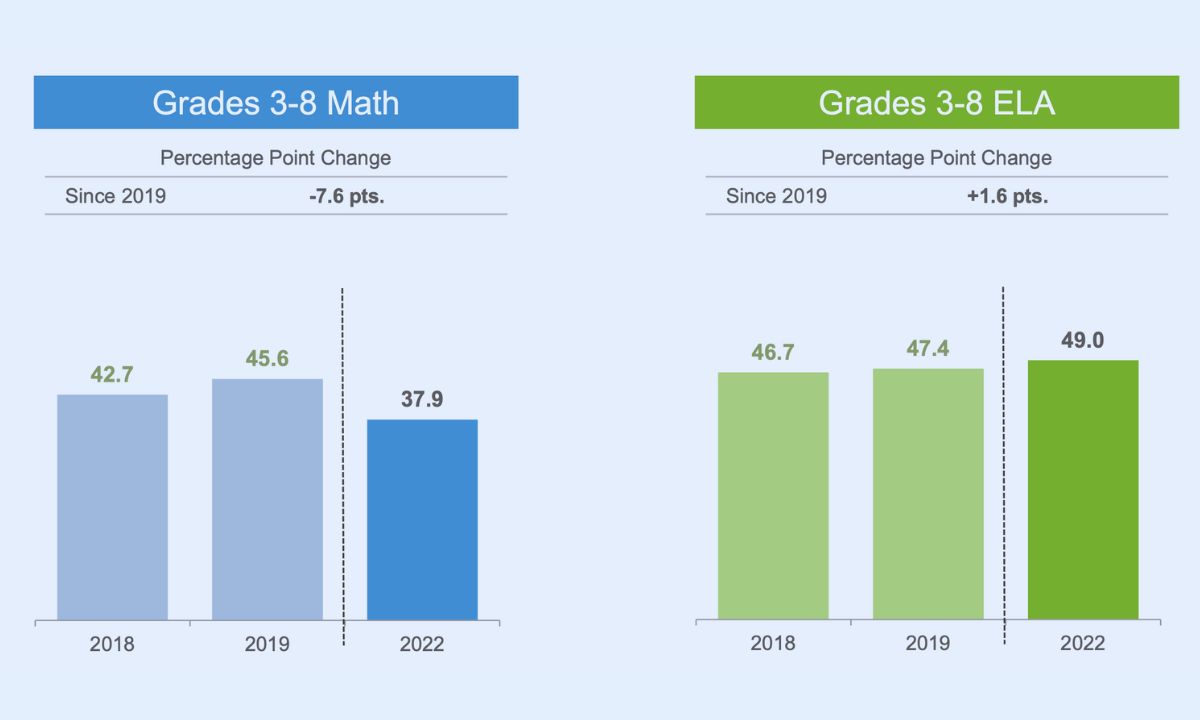
Get stories like this delivered straight to your inbox. Sign up for The 74 Newsletter
Updated, Sept. 29
New state test results released Wednesday by the New York City Department of Education offer a complicated picture of the pandemic’s effects on academic performance in America’s largest school district, showing students’ math performance tumbled but their English skills ticked upward from pre-pandemic levels.
Just over a third of students in grades 3 through 8 — 37.9% — were proficient in math, according to the new results released after COVID forced schools nationwide into remote learning and disrupted state assessments. That’s a 7.6 percentage point decline from 2019, suggesting deleterious effects of a pandemic that upended in-person learning.
But it’s complicated. Nearly half of students — 49% — scored proficient in English language arts, 1.6 percentage points higher than in 2019. The results, which city officials delayed releasing at the state’s request, offer the first comprehensive look at student performance during the pandemic. The state canceled the test in 2020 and made it optional in 2021. Roughly 10% of city students opted out of either the reading or math exams this year, considerably higher than the 4% who sat out in 2019, Chalkbeat reported.
“While results are complicated by the pandemic, the results reflect hard work by our students, families and educators during a difficult time,” DOE First Deputy Chancellor Dan Weisberg said, according to silive.com. “They also reflect opportunity gaps and outcomes in particular for Black and Hispanic students, as well as students with disabilities and English-language learners that are unacceptable.”
Tests administered outside New York City suggest, perhaps unsurprisingly, the public health emergency had a major negative impact on student learning. Earlier this month, results for the National Assessment of Educational Progress, often called the “nation’s report card,” found two decades of national growth in reading and math were wiped out by just two years of pandemic-induced disruptions. Declines were particularly stark among struggling students, further widening the performance gap between high- and low-achievers.
In Los Angeles, home to America’s second-largest school district, recent test results showed a significant drop in student achievement from pre-pandemic levels. Outcomes on the 2022 Smarter Balanced state assessment found just 28.47% of students were proficient in math and 41.67% met English standards. Among big city school districts, Los Angeles schools were among the longest closed to in-person learning while New York City was among the first to push to reopen classrooms, even while a majority of its families opted for remote learning well into the 2020-21 school year.
Looking forward, Weisberg said NYC schools are focused on transforming education so that every student graduates with “a pathway to a rewarding career, long-term economic security, and equipped to be a positive force for change in their community.”
Here are four key takeaways from the New York City test results:
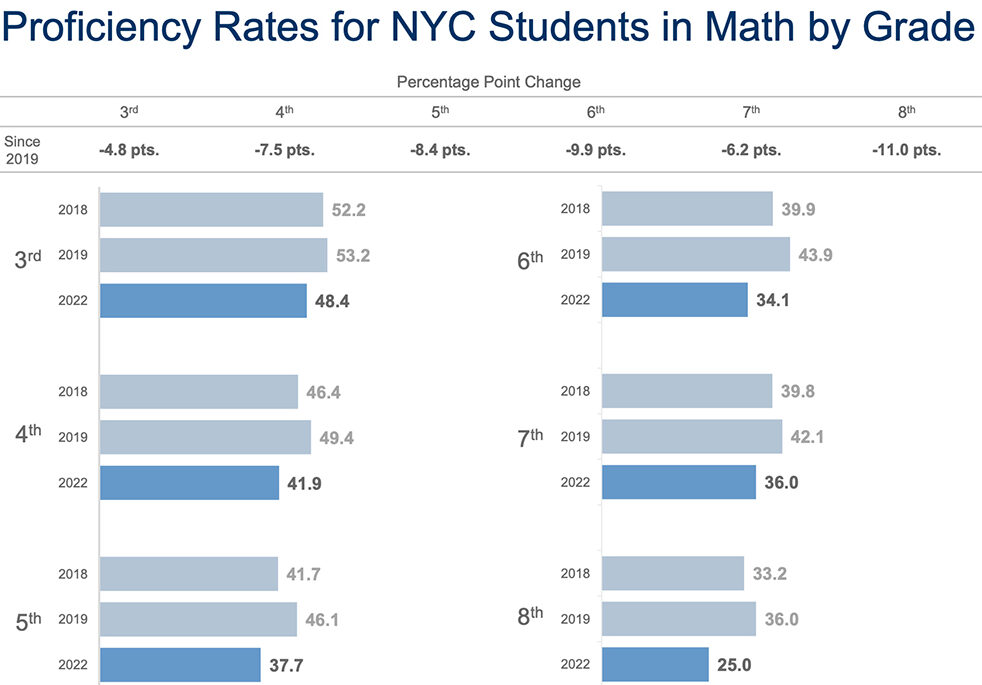
Woes in math were particularly profound for older students
Overall, just 37.9% of NYC students scored proficient in math, and students at all grade levels posted declines from pre-pandemic levels. But the downturn was particularly pronounced for students in middle school. Among third graders, 48.4% scored proficient, a 4.8 percentage point drop from 2019. Meanwhile, just 25% of eighth graders scored proficient in math, an 11 percentage point drop from pre-pandemic levels.
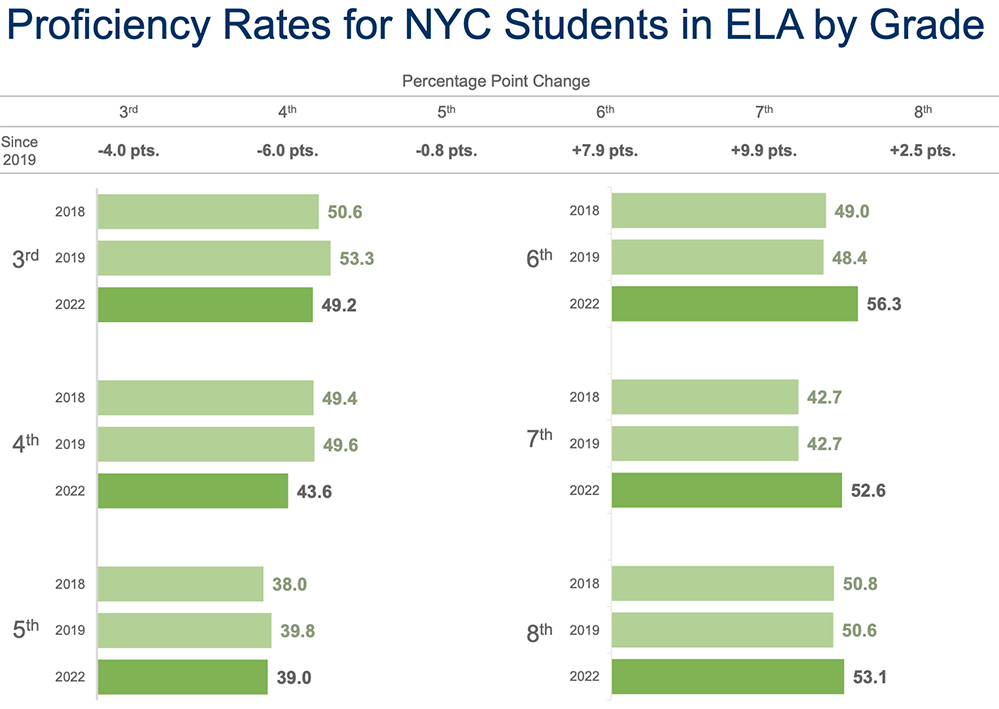
Younger students struggled with reading during the pandemic
NYC students posted gains in English language arts since 2019, and nearly half received a proficient score. But the results are more complicated when disaggregated by grade level. Younger students — particularly those in third and fourth grade — struggled while those in middle school outperformed pre-pandemic levels.
With a 6 percentage point decline from 2019, 43.6% of fourth graders scored proficient in English this year. That’s compared to 52.6 percent of seventh graders who scored proficient this year, up 9.9 percentage points from 2019.
Isabella Rieke, communications manager for Advocates for Children of New York, said the results underscored the urgency behind New York City moving to overhaul its reading program.
“While the overall ELA proficiency rate ticked upward, relative to 2019, the percentage of third graders scoring proficient fell by four percentage points and the rate for fourth graders fell by six percentage points,” she said in a statement. “These students would have been in first and second grades in March 2020—grades when children are mastering the relationships between sounds and letters and building the foundational literacy skills that will shape their future academic trajectory.”
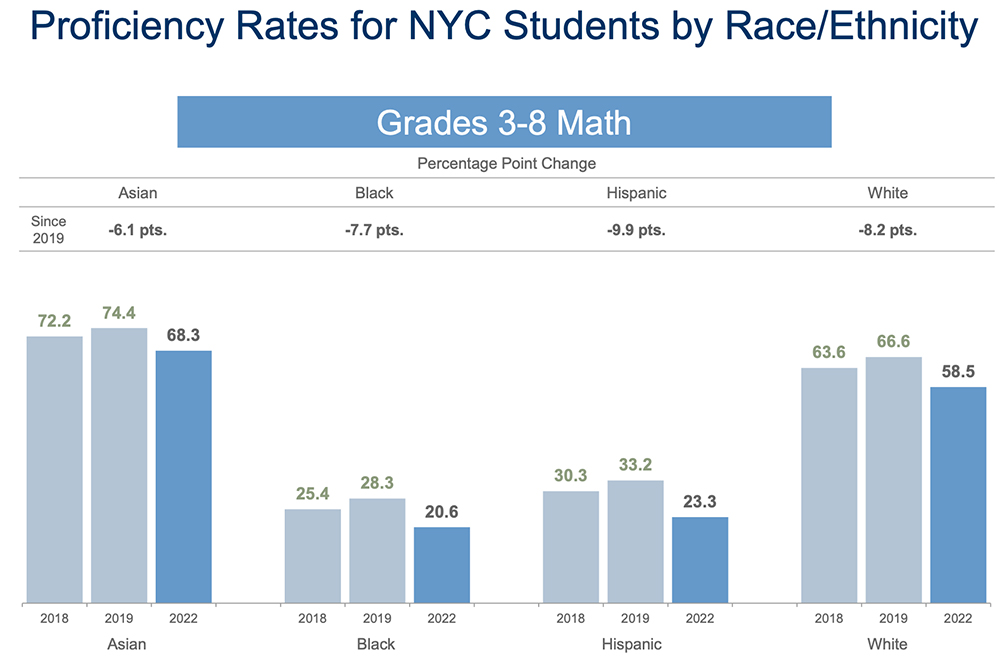
Declines were particularly stark for Black and Hispanic students
As has been the case for years, the latest test results showed significant disparities in New York City between white and Asian American students and their Black and Hispanic peers.
Among white students, 58.5% of students in third through eighth grade were proficient in math this year and 67.3% were proficient in English language arts. That’s an 8.2 percentage point decrease and a 0.7 percentage point increase, respectively.
Meanwhile, 20.6% of Black students scored proficient this year in math and 35.8% were proficient in English. Among Hispanic students, 23.3% were proficient in math and 36.8% were proficient in English. Hispanic students fared the worst during the pandemic, posting a 9.9 percentage point drop in math proficiency compared to 2019.
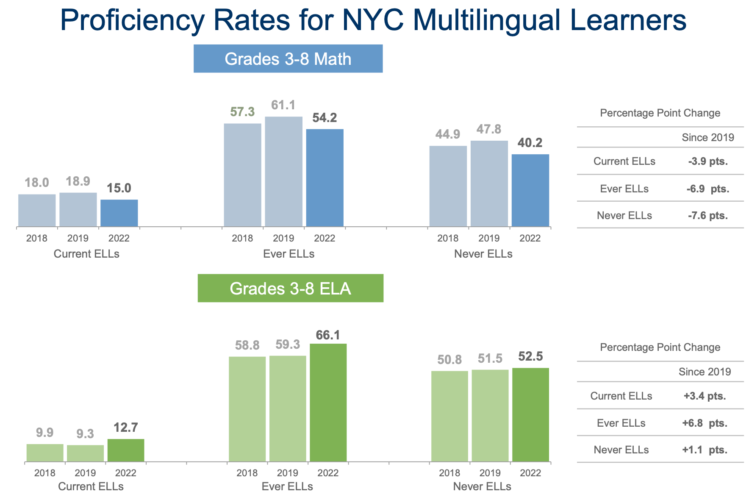
English learners and students with disabilities may have weathered the pandemic better than the general student population
While English language learners and those in special education had poorer performance than students overall in both math and English, test results suggest they weathered the pandemic better. Compared with 2019, English language learners saw a 3.9 percentage point drop in math while those who have never received the English language learner designation saw a 7.6 percentage point dip.
Similarly, English learners saw a 3.4 percentage point increase in their English proficiency since 2019 compared to a 1.1 percentage point increase for the general population.
Students with disabilities posted a 3.1 percentage point decline in math proficiency and a 2.2 percentage point increase in English. Meanwhile, students without disabilities saw an 8.9 percentage point drop in math proficiency and a 1.4 percentage point gain in English.
For some, the counterintuitive results raised red flags:
Get stories like these delivered straight to your inbox. Sign up for The 74 Newsletter

;)
